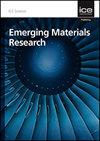Impact of solution chemistry on morphology of enzyme-induced calcium carbonate precipitate
IF 1.2
4区 材料科学
Q4 MATERIALS SCIENCE, MULTIDISCIPLINARY
引用次数: 0
Abstract
Enzyme-induced calcium carbonate precipitation (EICP) through the urea hydrolysis pathway has been widely studied for various applications. The EICP solution comprises urea, a calcium source (usually calcium chloride) and the enzyme urease. This study addressed the effect of the chemical concentration of the EICP solution on the morphology of the calcium carbonate product. This was achieved by varying the concentration of urea–calcium chloride and urease activity. The duration of the reaction was the third variable. The precipitation efficiency and the interface shearing resistance were reported. Precipitation efficiency decreased as the concentration of urea–calcium chloride reached beyond 0.75 mol/l. The calcium carbonate polymorph was predominantly calcite. Its crystal size and shape did, however, vary, depending on the precipitation conditions. The findings showed that the urease activity promoted the formation of rhombohedral calcite in the presence of adequate calcium ions and urea. Spherical calcite was formed when the urease activity was further increased. The morphology of calcite evolved from a single, uniform, smooth spherical crystal to a polycrystalline formation with orthorhombic protrusions. The crystals tended to grow as the reaction time increased, resulting in aggregation, when the urease levels crossed 30 kU/l. It was noted that spherical crystals exhibited stronger interface shearing resistance than rhombohedral crystals.溶液化学对酶促碳酸钙沉淀形态的影响
酶促碳酸钙沉淀(EICP)通过尿素水解途径得到了广泛的研究和应用。EICP溶液由尿素、钙源(通常是氯化钙)和脲酶组成。本研究探讨了EICP溶液的化学浓度对碳酸钙产物形貌的影响。这是通过改变尿素氯化钙浓度和脲酶活性来实现的。反应的持续时间是第三个变量。报道了析出效率和界面抗剪切性能。当尿素-氯化钙浓度超过0.75 mol/l时,沉淀效率下降。碳酸钙多晶型以方解石为主。然而,它的晶体大小和形状确实因降水条件而异。结果表明,在钙离子和尿素充足的条件下,脲酶活性促进方解石的形成。进一步提高脲酶活性,形成球形方解石。方解石的形态由单一、均匀、光滑的球形晶体演变为具有正交凸体的多晶结构。当脲酶浓度超过30 kU/l时,随着反应时间的延长,结晶逐渐长大,形成聚集。结果表明,球形晶体比菱形晶体具有更强的界面抗剪切能力。
本文章由计算机程序翻译,如有差异,请以英文原文为准。
求助全文
约1分钟内获得全文
求助全文
来源期刊

Emerging Materials Research
MATERIALS SCIENCE, MULTIDISCIPLINARY-
CiteScore
4.50
自引率
9.10%
发文量
62
期刊介绍:
Materials Research is constantly evolving and correlations between process, structure, properties and performance which are application specific require expert understanding at the macro-, micro- and nano-scale. The ability to intelligently manipulate material properties and tailor them for desired applications is of constant interest and challenge within universities, national labs and industry.
 求助内容:
求助内容: 应助结果提醒方式:
应助结果提醒方式:


